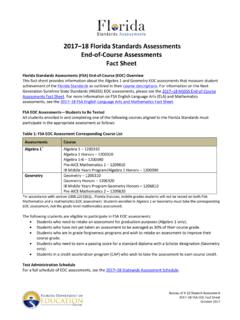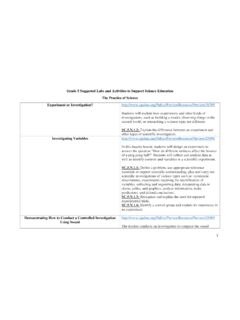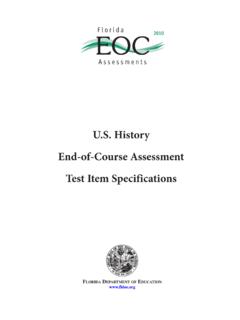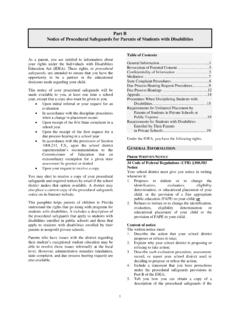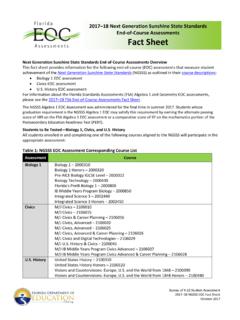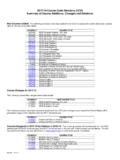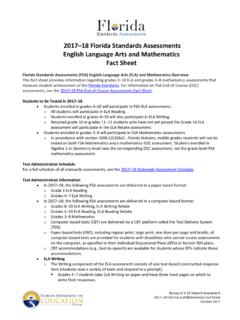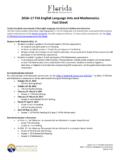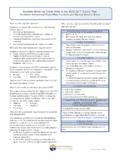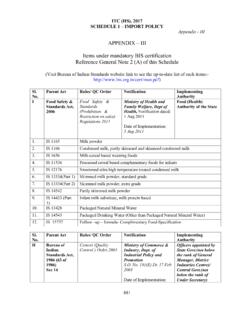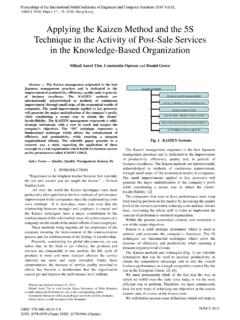Transcription of Instructional Guidance for Transition to the New B.E.S.T ...
1 1 | Page Instructional Guidance for Transition to the New Standards for Mathematics The purpose of this document is to provide educators with an overview of major changes in mathematical concepts within the courses incorporating the Benchmarks for Excellent Student Thinking ( ) Standards for Mathematics as compared to the current courses utilizing the Mathematics Florida Standards (MAFS). It is important for educators to understand these changes in courses to ensure that students do not have any generational learning gaps during implementation of the Standards for Mathematics during the 2022-2023 school year.
2 2 | Page Table of Contents Kindergarten .. 3 Grade 1 .. 5 Grade 2 .. 7 Grade 3 .. 9 Grade 4 .. 12 Grade 5 .. 15 Grade 6 .. 17 Grade 7 .. 19 Grade 8 .. 21 Algebra 1 .. 23 Algebra 1 Honors .. 25 27 Geometry Honors .. 29 Algebra 2 .. 31 Algebra 2 Honors .. 33 Precalculus Honors .. 34 3 | Page Kindergarten Starting in the 2022-2023 school year, the Kindergarten Mathematics Instructional time will emphasize three areas: (1) developing an understanding of counting to represent the total number of objects in a set and to order the objects within a set; (2) developing an understanding of addition and subtraction and the relationship of these operations to counting; and (3) measuring, comparing and categorizing objects according to various attributes, including their two- and three-dimensional shapes.
3 Planning for Student Learning and Instruction in the 2021-2022 School Year In the 2021-2022 school year, Kindergarten Mathematics students will still receive instruction in the current MAFS. To prepare for implementation of the Standards for Mathematics, the Department has identified possible mathematical concepts that may cause gaps in future courses aligned to the Standards for Mathematics. Below is a table of concepts, by strand within the Standards, that could be embedded within instruction of the MAFS to ensure students will be successful in Grade 1 Mathematics in the 2022-2023 school year.
4 Please note that this list is not comprehensive and educators are encouraged to find other changes from the current MAFS course to the course. Each concept is referenced as the following: benchmark coding scheme o benchmark language Identifies the new concept or changes to the current expectation Number Sense and Operations o Identify positions of objects within a sequence using the words first, second, third, fourth or fifth. New to Kindergarten. o Compare the number of objects from 0 to 20 in two groups using the terms less than, equal to or greater than.
5 Number range is now from 0 to 20. o Recite the number names to 100 by ones and by tens. Starting at a given number, count forward within 100 and backward within 20. Counting backward within 20 is new to Kindergarten. o Locate, order and compare numbers from 0 to 20 using the number line and terms less than, equal to or greater than. Number range is now from 0 to 20 and the use of the number line to compare is new to Kindergarten. 4 | Page Number Sense and Operations o Add two one-digit whole numbers with sums from 0 to 10 and subtract using related facts with procedural reliability.
6 Number range is now from 0 to 10 and instruction focuses on helping a student choose a method they can use reliably. Algebraic Reasoning o Explain why addition or subtraction equations are true using objects or drawings. New to Kindergarten. Measurement o Identify the attributes of a single object that can be measured such as length, volume or weight. Concept of volume is new to Kindergarten. o Express the length of an object, up to 20 units long, as a whole number of lengths by laying non-standard objects end to end with no gaps or overlaps. Measurement lengths up to 20 units long is new to Kindergarten.
7 Geometric Reasoning Within Geometric Reasoning, figures are now limited to circles, triangles, rectangles, squares, spheres, cubes, cones and cylinders. Data Analysis and Probability o Collect and sort objects into categories and compare the categories by counting the objects in each category. Report the results verbally, with a written numeral or with drawings. Report the results verbally, with a written numeral or with drawings is new to Kindergarten. 5 | Page Grade 1 Starting in the 2022-2023 school year, the Grade 1 Mathematics Instructional time will emphasize four areas: (1) understanding the place value of tens and ones within two-digit whole numbers; (2) extending understanding of addition and subtraction and the relationship between them; (3) developing an understanding of measurement of physical objects, money and time; and (4) categorizing, composing and decomposing geometric figures.
8 Planning for Student Learning and Instruction in the 2021-2022 School Year In the 2021-2022 school year, Grade 1 Mathematics students will still receive instruction in the current MAFS. To prepare for implementation of the Standards for Mathematics, the Department has identified possible mathematical concepts that may cause gaps in future courses aligned to the Standards for Mathematics. Below is a table of concepts, by strand within the Standards, that could be embedded within instruction of the MAFS to ensure students will be successful in Grade 2 Mathematics in the 2022-2023 school year.
9 Please note that this list is not comprehensive and educators are encouraged to find other changes from the current MAFS course to the course. Each concept is referenced as the following: benchmark coding scheme o benchmark language Identifies the new concept or changes to the current expectation Number Sense and Operations o Starting at a given number, count forward and backwards within 120 by ones. Skip count by 2s to 20 and by 5s to 100. Counting backwards within 120 by ones, and skip counting by 2s to 20 and by 5s to 100 are new to grade 1. o Read numbers from 0 to 100 written in standard form, expanded form and word form.
10 Write numbers from 0 to 100 using standard form and expanded form. Reading numbers in word form and expanded form, and writing numbers in expanded form are new to grade 1. o Plot, order and compare whole numbers up to 100. Plotting and ordering numbers are new to grade 1. o Recall addition facts with sums to 10 and related subtraction facts with automaticity. Recall with automaticity is new to grade 1. 6 | Page Number Sense and Operations o Explore subtraction of a one-digit number from a two-digit number. New to grade 1. Algebraic Reasoning o Apply properties of addition to find a sum of three or more whole numbers.
